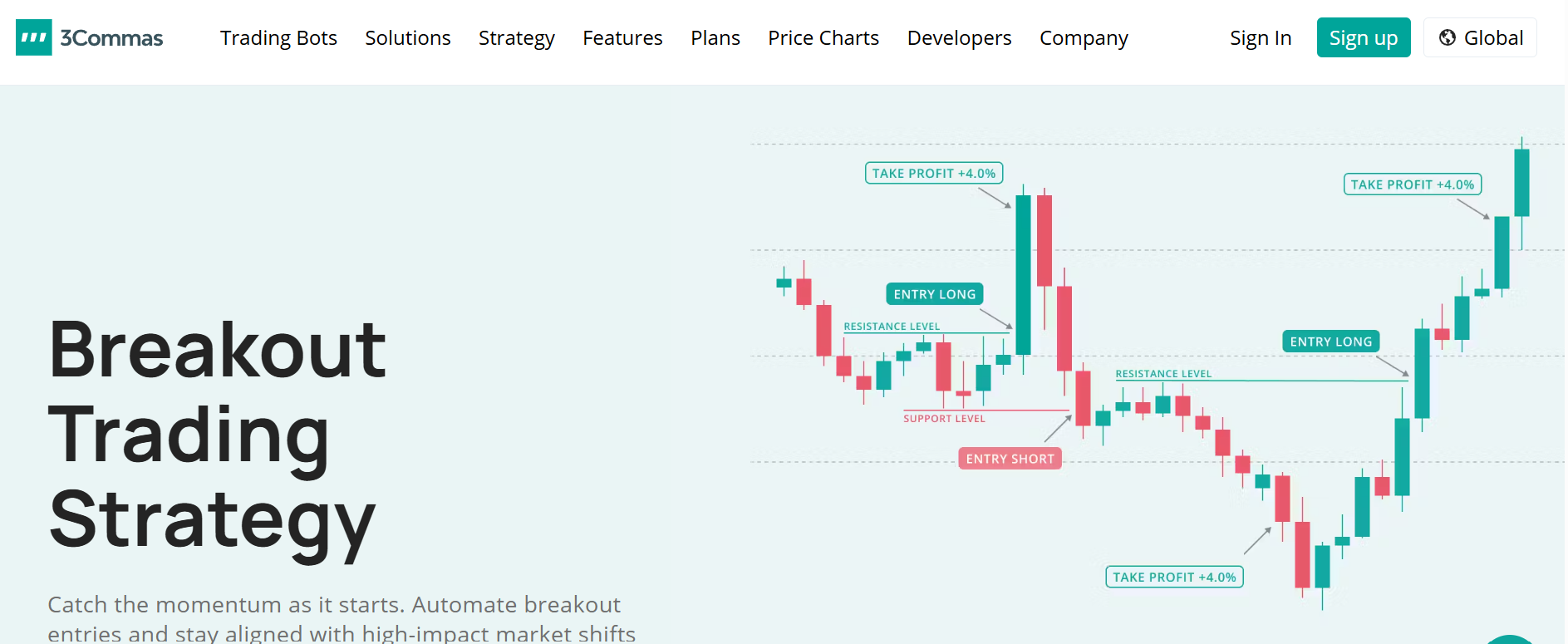In this 2025 guide, we compare the top crypto algo trading platforms, include real user reviews, and share a simple example strategy you can test right away.
1. 3Commas — Multi-Exchange Automation
Best for: Active traders managing multiple exchange accounts.
3Commas offers a clean, centralized interface to deploy bots, manage portfolios, and execute trades across Binance, Coinbase, OKX, and others. Its SmartTrade terminal lets you pre-set entries and exits, while DCA and grid bots automate execution.
Pros: intuitive UI, wide exchange coverage, backtesting, and ready-made bot templates.
Cons: API setup can be complex; support can lag during high-traffic periods.
User Reviews:
-
Trustpilot (4.4/5, 1,700+ reviews): Users praise SmartTrade and automation simplicity — “Being able to preset take profit and stop loss saves me from staring at screens all night.”
-
G2 (4.5/5): “Excellent automation tools but requires time to master. The UI is sleek and integrations are strong.”
-
Critiques: A few traders mention bot errors during volatile markets or delayed responses from support.
Verdict: 3Commas remains the most feature-rich retail platform for multi-exchange automation. It rewards users who invest time learning its system.
2. Pionex — Built-In Exchange Bots
Best for: Beginners who want plug-and-play bots without coding.
Pionex is an exchange with 16+ pre-built bots — including grid, DCA, and rebalancing strategies — that run natively on its servers. This makes it one of the easiest ways to automate trades instantly.
Pros: extremely low barrier to entry; no extra bot fees; strong mobile app.
Cons: limited to Pionex markets and predefined strategies.
User Reviews:
-
Trustpilot (4.3/5): “Best entry-level platform. The bots are easy, low fees, and I can run them 24/7 without setup headaches.”
-
Google Play: “Excellent UI, countless bots, and accurate profit tracking.”
-
Critiques: Some Reddit users report limited profitability — “Grid bots make small profits, but over time high volatility cancels gains.”
Verdict: Pionex is unbeatable for simplicity. It’s perfect for newcomers testing automation before moving to custom logic.
3. Coinrule — No-Code Conditional Rules
Best for: Traders who want to design custom strategies without programming.
Coinrule lets you build rule-based automation (“If price drops 5% and RSI < 40 → Buy BTC”). Its drag-and-drop logic connects to major exchanges and supports historical backtesting.
Pros: intuitive rule engine; wide exchange support; strong educational tutorials.
Cons: limited flexibility for multi-factor strategies; backtests assume ideal fills.
User Reviews:
-
Trustpilot (4.1/5): “Easy to start; my DCA and breakout rules work well. Backtests are straightforward.”
-
Reddit feedback: users appreciate templates, but note the pricing tiers could be cheaper for high-frequency setups.
Verdict: Coinrule is ideal for non-coders who want structure and logic without scripting. A great entry point before moving to Trality or Freqtrade.
4. Cryptohopper — Cloud Bots & Marketplace
Best for: Traders seeking automation with community strategies.
Cryptohopper runs fully in the cloud — no server setup. You can design your own bot, subscribe to trading signals, or copy from a marketplace of professional traders.
Pros: hosted bots, paper trading, community marketplace, integration with TradingView signals.
Cons: marketplace quality varies; webhook trading has occasional glitches.
User Reviews:
-
Trustpilot (3.7/5): “It helps trade without emotion, but it’s not a money-printing machine. You still need a strategy.”
-
G2 (4.3/5): praised for automation breadth and integration; criticized for minor UI bugs.
-
Reddit: “After a year, I’m around break-even — great tool, but you still need to tune your strategy.”
Verdict: Cryptohopper is versatile and cloud-ready, great for traders who prefer managed hosting and social strategy sharing.
5. Zignaly — Copy Trading & Profit-Sharing
Best for: Passive investors who want pro traders to manage capital.
Zignaly connects users to experienced traders who trade on their behalf for a success fee. It’s essentially social trading meets hedge-fund-style profit sharing.
Pros: success-fee model (pay only when profitable), transparency of trader stats.
Cons: variable manager quality; occasional withdrawal or performance complaints.
User Reviews:
-
Trustpilot (4.0/5): “Beginner-friendly, easy to allocate to traders and learn.”
-
Another user warns: “Some fund managers went inactive, and withdrawals got delayed.”
Verdict: Excellent for those seeking passive exposure — but always diversify across multiple managers to reduce dependency risk.
6. Bitsgap — Grids, Arbitrage & Multi-Exchange Control
Best for: Intermediate to advanced traders seeking cross-exchange capabilities.
Bitsgap acts as a hub for bots, arbitrage opportunities, and portfolio management across 20+ exchanges.
Pros: strong arbitrage scanner, intuitive grid bot configuration, unified dashboard.
Cons: Arbitrage profits depend on fast execution; setup can be heavy for newcomers.
User Reviews:
-
Capterra (4.6/5): “Provides awesome tools — signals, arbitrage, and grid bots in one place.”
-
Reddit discussions: traders like the interface and stability, but caution about overfitting grid spacing.
Verdict: Bitsgap is an excellent multi-exchange workbench. It’s especially good for traders running parallel grids or arbitrage across venues.
7. Kryll — Visual Strategy Builder
Best for: Visual learners who prefer a drag-and-drop strategy design.
Kryll replaces code with flowcharts — connect indicators and triggers visually, backtest, and deploy. It also has a strategy marketplace where you can share or rent flows. Kryll is a decentralized platform and is compatible with Metamask.
Pros: visual editor, flexible components, pay-as-you-go model.
Cons: limited advanced math; visual logic can feel slow for complex systems.
User Reviews:
-
Trustpilot (4.2/5): “The drag-and-drop builder is the easiest way I’ve built strategies.”
-
YouTube creators highlight Kryll’s marketplace transparency and active Discord community.
Verdict: Ideal for educational or demo purposes. A strong midpoint between ease and customization.
8. Trality — Python in the Browser
Best for: Developers who want to code but prefer managed hosting.
Trality provides a full Python IDE inside your browser. It lets you backtest, version control, and even rent out strategies via its marketplace.
Pros: true coding flexibility without server setup; excellent documentation.
Cons: requires Python familiarity; limited to supported data intervals.
User Reviews:
-
Trustpilot (4.5/5): “Love coding bots without managing servers. Backtests are accurate and stable.”
-
Some developers request faster data updates and more exchanges.
Verdict: The perfect stepping stone for coders who want full control but minimal infrastructure work.
9. Freqtrade — Open-Source Framework
Best for: Advanced traders and quants building institutional-grade systems.
Freqtrade is a self-hosted Python framework that supports custom strategies, hyper-parameter optimization, and paper/live trading via exchange APIs.
Pros: full transparency, community support, detailed logging.
Cons: setup and maintenance require technical knowledge (Docker, cron, servers).
User Reviews:
-
GitHub (19k+ stars): users commend its active community and regular updates.
-
Reddit: “Best for serious algo traders. It’s not plug-and-play but it’s professional.”
Verdict: If you want the deepest control, Freqtrade is the benchmark open-source solution.
10. Quick Comparison Table
| Platform | Best For | Skill | Multi-Exchange | Backtesting | Demo/Paper | Avg Rating |
|---|---|---|---|---|---|---|
| 3Commas | Multi-exchange automation | Intermediate | ✅ | Good | ✅ | ★★★★☆ |
| Pionex | Built-in on-exchange bots | Beginner | ❌ | Basic | Limited | ★★★★☆ |
| Coinrule | Rule-based automation | Beginner | ✅ | Simplified | ✅ | ★★★★ |
| Cryptohopper | Cloud bots + copy | Intermediate | ✅ | Variable | ✅ | ★★★½ |
| Zignaly | Profit-sharing | Beginner | ✅ | N/A | Allocations | ★★★★ |
| Bitsgap | Grids & arbitrage | Intermediate | ✅ | Advanced | ✅ | ★★★★½ |
| Kryll | Visual strategies | Beginner | ✅ | Built-in | ✅ | ★★★★ |
| Trality | Python scripting | Developer | ✅ | High | ✅ | ★★★★½ |
| Freqtrade | Open-source control | Developer | ✅ | Highest | Sim/Live | ★★★★★ |
Example Strategy — DCA + Momentum Filter
A straightforward, risk-controlled framework that works across most platforms.
Goal: accumulate during dips, pause in volatile surges.
-
Pair: BTC/USDT
-
Signal: RSI(14) on 1-hour candles
-
Rules:
-
Buy 2% of portfolio every 4 hours when RSI < 35
-
Stop when RSI > 50
-
Pause if 1-hour ATR > 1.8× its 90-day average
-
-
Risk limits: per trade 2%; weekly exposure ≤15%; stop after 3 failed API calls
Platforms supported:
-
Coinrule — rule-based logic
-
3Commas — DCA bot with conditions
-
Pionex — grid/DCA setup
-
Trality / Freqtrade — Python code for full automation
This combination balances patience (DCA) with discipline (momentum filter), reducing drawdowns during whipsaws.
What Users Agree On
Across all reviews, three themes stand out:
-
Ease matters: most users start with Pionex, Coinrule, or 3Commas before moving to advanced tools.
-
Expect learning curve: profitable automation requires iteration — bots amplify discipline, not luck.
-
Support and transparency: platforms that respond quickly and show strategy results clearly earn the highest trust.
Final Thoughts
-
If you’re new: start with Coinrule — quick setup and simple logic.
-
If you trade multiple exchanges, use 3Commas or Bitsgap.
-
If you prefer copy trading, explore Zignaly or Cryptohopper.
-
If you code, build on Trality or Freqtrade for ultimate control.
Whatever you choose, begin with paper mode, measure results, and treat bots as structured research tools — not shortcuts to instant profit.





